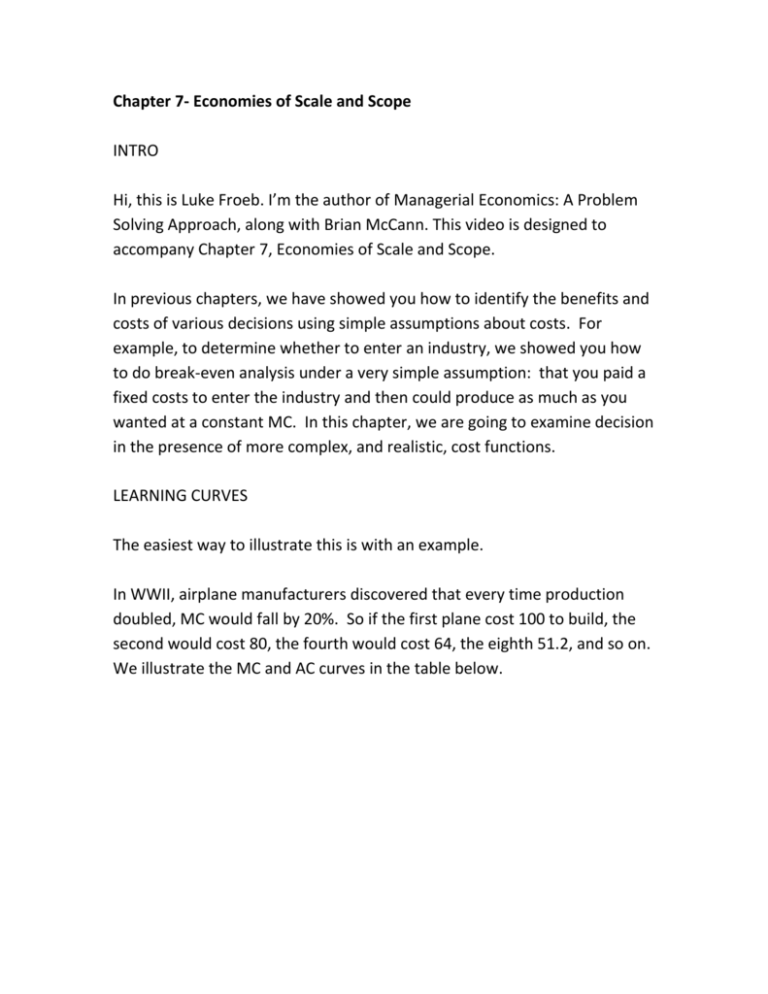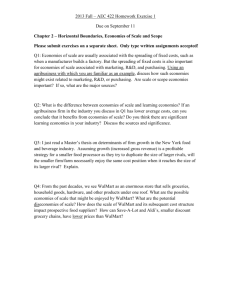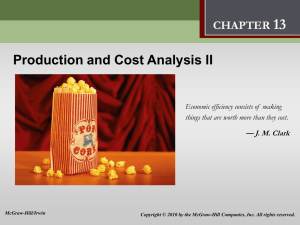Chapter 7 Script - Vanderbilt Business School
advertisement

Chapter 7- Economies of Scale and Scope INTRO Hi, this is Luke Froeb. I’m the author of Managerial Economics: A Problem Solving Approach, along with Brian McCann. This video is designed to accompany Chapter 7, Economies of Scale and Scope. In previous chapters, we have showed you how to identify the benefits and costs of various decisions using simple assumptions about costs. For example, to determine whether to enter an industry, we showed you how to do break-even analysis under a very simple assumption: that you paid a fixed costs to enter the industry and then could produce as much as you wanted at a constant MC. In this chapter, we are going to examine decision in the presence of more complex, and realistic, cost functions. LEARNING CURVES The easiest way to illustrate this is with an example. In WWII, airplane manufacturers discovered that every time production doubled, MC would fall by 20%. So if the first plane cost 100 to build, the second would cost 80, the fourth would cost 64, the eighth 51.2, and so on. We illustrate the MC and AC curves in the table below. What is interesting about this example is that the MC curve is always below the AC, which causes the average to fall. We show this in the graph below. The declining AC curve is an example of what economists call “economies of scale.” Average cost declines with production. Learning curves are just one example of scale economies. So how does this declining average cost curve affect decision making? Imagine that you are a stock market analyst following Airbus, and you have to decide whether to recommend the stock of the company. They have just come to market with their new wide body, double deck airplane, the Airbus 380, <<INSERT PHOTO OF PLANE >> and the success of the company depends on the success of this product. Imagine that the costs of the 380 are similar to those in the graph and table above. What kind of analysis would you do to determine whether this plane is going to be commercially successful? Since each plane produced lowers the cost of future planes, the company’s health obviously depends whether it can sell enough to get the costs down to a point where consumers are going to want to buy them. To calculate costs, you would first have to figure out how many planes they are going to sell over the lifetime of the airplane. If demand is big enough to bring the costs below the value, then the plane has a chance of becoming successful. In the late 1960’s, this exact same problem confronted Bruce Henderson, founder of Boston Consulting Group. Lockheed had come out with its new Tristar military transport plane and Professor Henderson correctly forecast that Lockheed would never sell enough of the planes to bring costs down to the point where they were affordable. Sure enough, the company had to be bailed out by the US government in 1971, due largely to the commercial failure and cost over runs of the big plane. Professor Henderson’s work quantifying the effect of learning curves, and their strategic implications, demonstrated the value of economics to the field of strategy, which at that time was dominated by academics from the less quantitative disciplines. COST SHAPE INDUSTRIES To illustrate how such scale shape industries, consider beer. From 1947 through 1995, beer consumption doubled in the US but the number of brewers dropped by more than 90 percent. We saw the demise of once popular brands like Schlitz and the growth of a few giant companies. In the US, the so called “premium” beer segment is now dominated by Anheuser Busch, Miller, and Coors, with enormous plants capable of producing over 8 million gallons each year. The low cost of their large scale has allowed them to driven some smaller competitors in the premium segment out of business. But the lower costs associated with large output is only part of the story. The other is distribution. A beer manufacturer cannot simply expand the size of its manufacturing plant to take advantage of scale economies; rather it must also consider that the larger output must be shipped further to consumers. Thus a larger plant may experience economies of scale, but diseconomies of transport. These diseconomies include not only the cost of shipping the beer, but also the reduced freshness of the product. Anheuser Busch which makes the popular Budweiser Brand has evolved into a network of 12 plants <<NETWORK MAP http://www.buschjobs.com/docs/locations.html>>, located near population centers and enjoys a reputation for producing fresher beer than its competitors. It ships its beer only 200 to 250 miles on average, while Coors—at least before they merged with Miller--with far fewer facilities, ships its beer an average of over 1,000 miles.1 Interestingly, the big US beer manufacturers missed a big shift in US demand towards what are known as “craft, speciality, and imported” beers, like Sam Adams, Anchor Steam, and Beck’s. Despite the much higher costs associated with the lower volume or reduced freshness associated with imported beers, this segment of the industry has captured about 15% market share, and is growing rapidly. ECONOMIES OF SCOPE: The basic idea behind economies of scope is simple. If the cost of producing two products together is cheaper than producing them separately, then we say the two activities exhibit economies of scope. <<REPRESENT THIS AS C(Q1,Q2)<C(Q1)+C(Q2) with arrows pointing to the first expression as I say “together” and arrows pointing at the other two expressions as I say “separately” >> This is the reason that most restaurants sell lunch and dinner, instead of just one or the other. This is also the reason that Starbucks is considering selling wine in their coffee houses at night. <<SIMPLE GRAPHIC?>> Since the fixed assets - both the brand name and restaurants would represent common costs for both morning and evening beverages, there are likely to be economies of scope between the two. CONCLUSION: The bottom line between economies of scope and scale is pretty obvious: try to take advantage of them. However, as 1 Kenneth G. Elzinga. (2005). “Beer,” in Walter Adams and James W. Brock (editors), THE STRUCTURE OF AMERICAN INDUSTRY, Eleventh Edition, Upper Saddle River (hereinafter “Elzinga”) at page 81. in any decision, you have to consider all the costs and benefits of a decision. Economies of scope and scale likely tell only part of the story.








